Guest Blogging: The Definitive Guide
Written by Brian Dean

This guide contains everything you need to know about guest blogging.
How to start.
How to scale.
And how to get your guest post featured on HUGE authority sites in 2023.
With that, here are the steps:
- Step #1: Find Guest Post Targets
- Step #2: Get Your Guest Post Ready
- Step #3: Send Your Pitch
- Step #4: Write Your Guest Post
- Step #5: Follow Up
- Bonus Step #1: The Expanded Guest Post
- Bonus Step #2: Guest Blogging Pro Tips
About The Author
Hey, I’m Brian Dean.
Over the last few years I’ve published over 200 guest posts.
Some of these guest posts were on smaller niche sites like this:

But I’ve also published guest posts on HUGE blogs in the marketing space, like the Buffer blog:
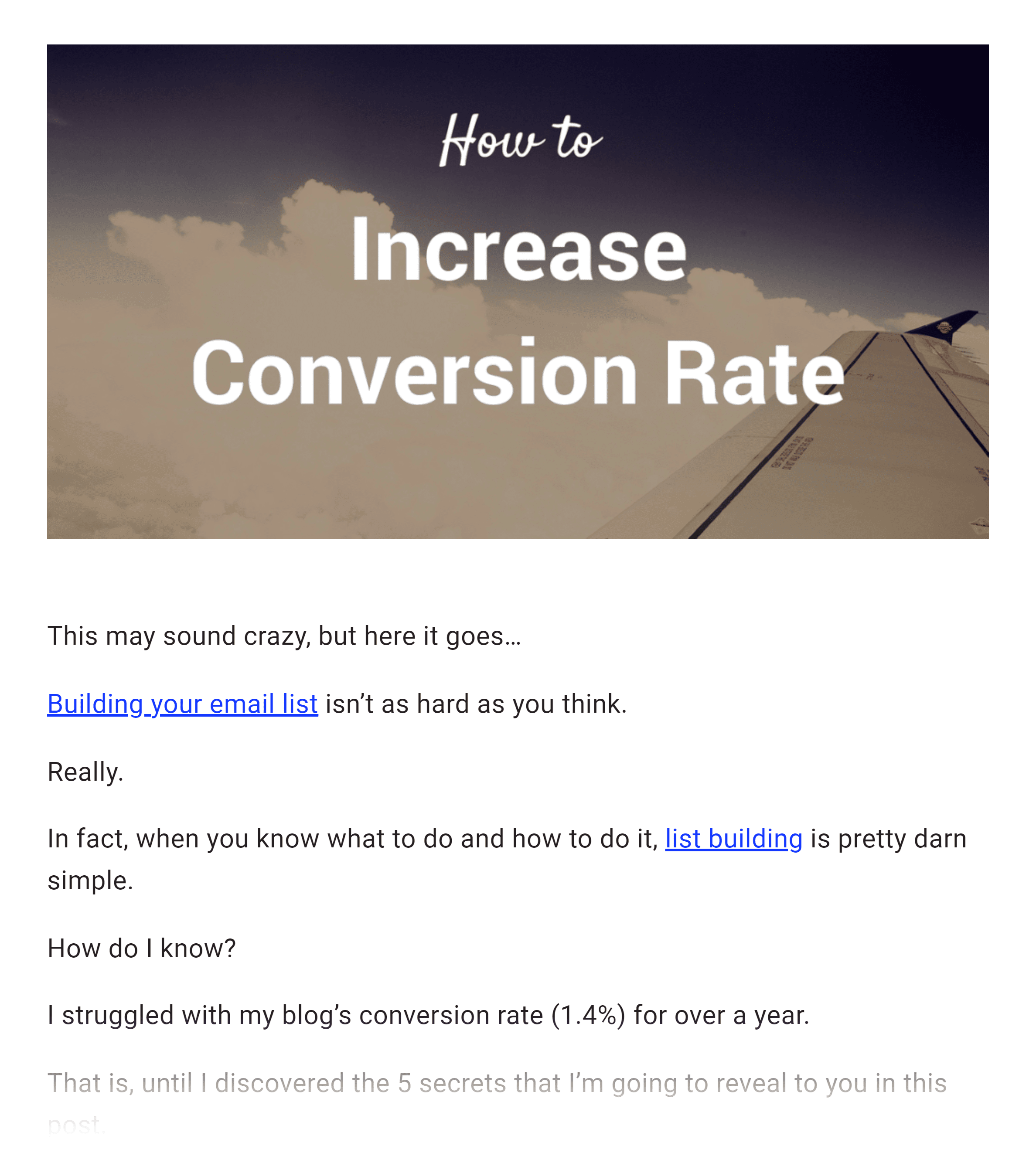
I’ve even had my content published on authority sites like Entrepreneur and Inc.

Needless to say, these guest posts have generated thousands of targeted visitors to my site.
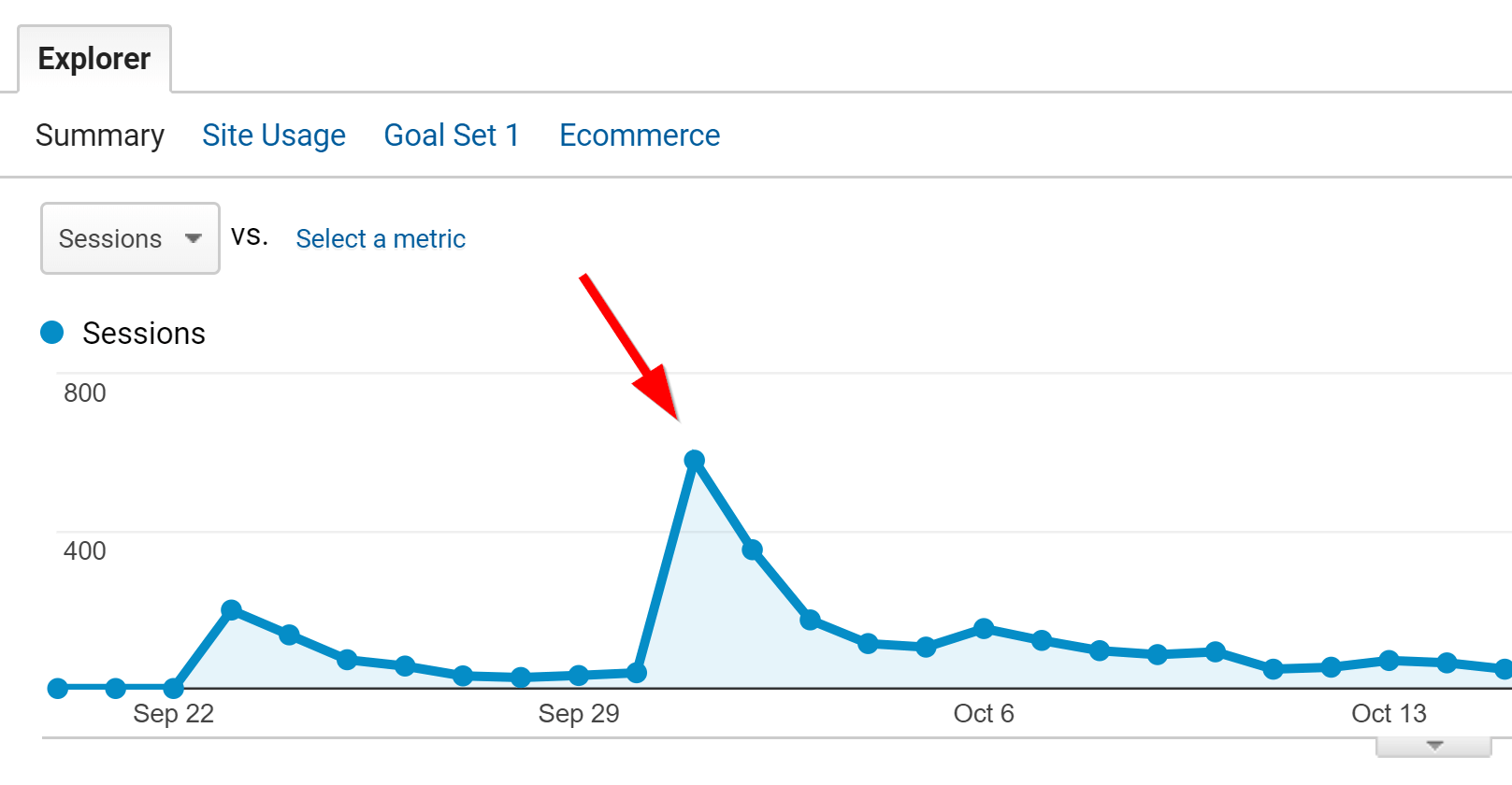
(Not to mention powerful backlinks that have significantly improved my Google rankings.)
And in this guide, I’m going to reveal exactly how I did it.
Step #1: Find Guest Post Targets
Your first step is to find a site to guest post on.
Here are 7 proven ways to find sites that accept guest posts:
Technique #1: Google Search Strings
Looking for something besides the typical “keyword” + “write for us” search string?
I’ve got you covered.
Here’s a list of search strings that I personally use to find guest posting opportunities:
Your Keyword “guest post”
Your Keyword “write for us”
Your Keyword “guest article”
Your Keyword “guest post opportunities”
Your Keyword “this is a guest post by”
Your Keyword “contributing writer”
Your Keyword “want to write for”
Your Keyword “submit blog post”
Your Keyword “contribute to our site”
Your Keyword “guest column”
Your Keyword “submit content”
Your Keyword “submit your content”
Your Keyword “submit post”
Your Keyword “This post was written by”
Your Keyword “guest post courtesy of ”
Your Keyword “guest posting guidelines”
Your Keyword “suggest a post”
Your Keyword “submit an article”
Your Keyword “contributor guidelines”
Your Keyword “contributing writer”
Your Keyword “submit news”
Your Keyword “become a guest blogger
“Your Keyword “guest blogger”
Your Keyword “guest posts wanted”
Your Keyword “looking for guest posts”
Your Keyword “guest posts wanted”
Your Keyword “guest poster wanted”
Your Keyword “accepting guest posts”
Your Keyword “writers wanted”
Your Keyword “articles wanted”
Your Keyword “become an author”
Your Keyword “become guest writer”
Your Keyword “become a contributor”
Your Keyword “submit guest post”
Your Keyword “submit an article”
Your Keyword “submit article”
Your Keyword “guest author”
Your Keyword “send a tip”
Your Keyword inurl: “guest blogger”
Your Keyword inurl: “guest post”
allintitle: Your Keyword + guest post
Technique #2: Google Reverse Image Search
This is cool:
First, find someone in your niche that writes a lot of guest posts.
For example, Noah Kagan tends to contribute to a lot of blogs in the marketing space.

Second, grab the URL of the headshot they use in their author bio:
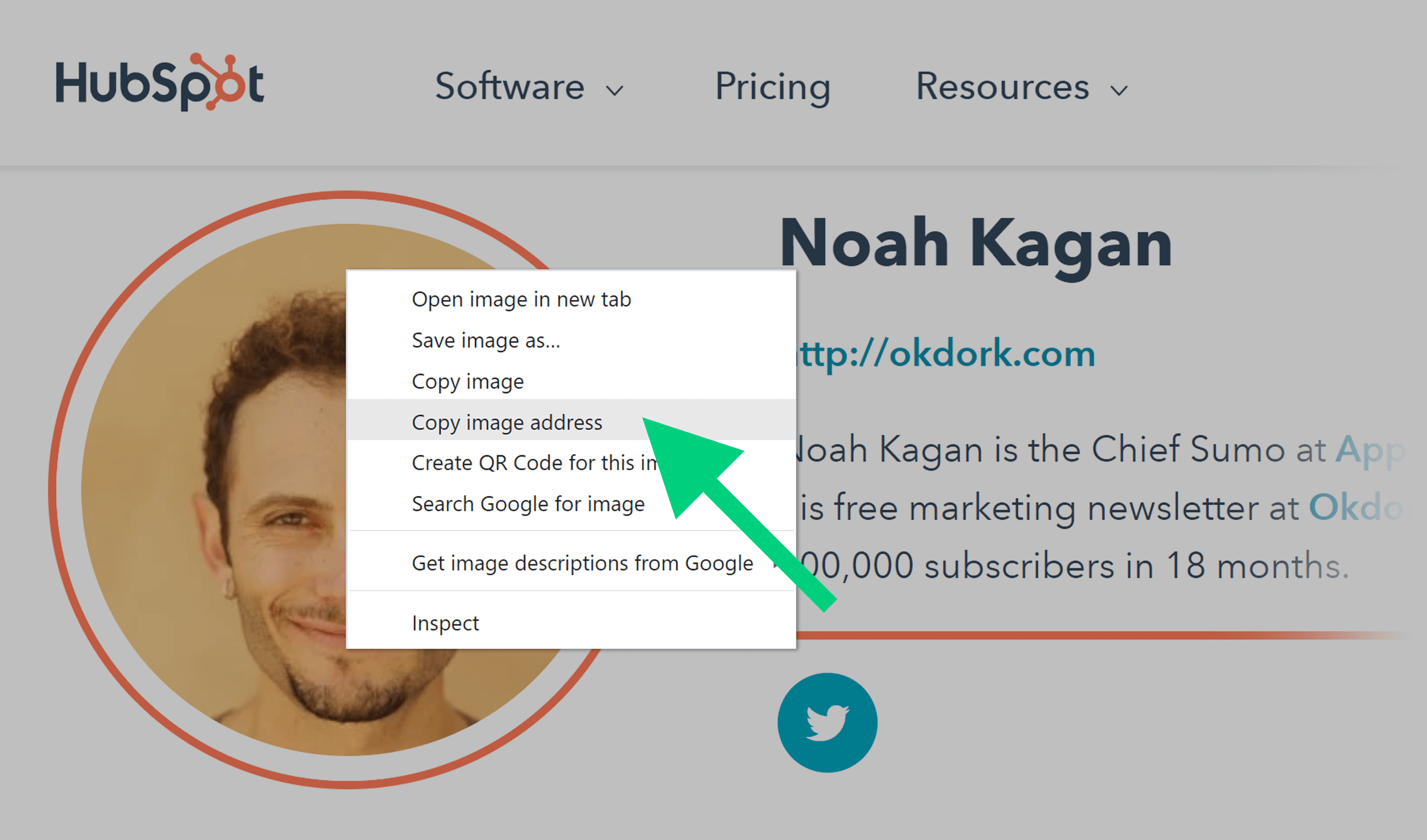
Finally, pop that into Google reverse image search:

Boom! You get a list of places they’ve guest posted… presented to you on a silver platter:

Technique #3: Twitter Search
Twitter search is an untapped goldmine.
In fact, I’ve found some AMAZING guest blogging opportunities on Twitter…
…opportunities that I would have never found in Google.
(Also, Twitter results are fresher than Google’s index. This means you can find sites that are actively on the hunt for guest posts.)
Here’s how to do it:
First, head over to Twitter search and enter a basic guest post search string like “[keyword]” guest post.

Then, look through the results to find guest posting targets:
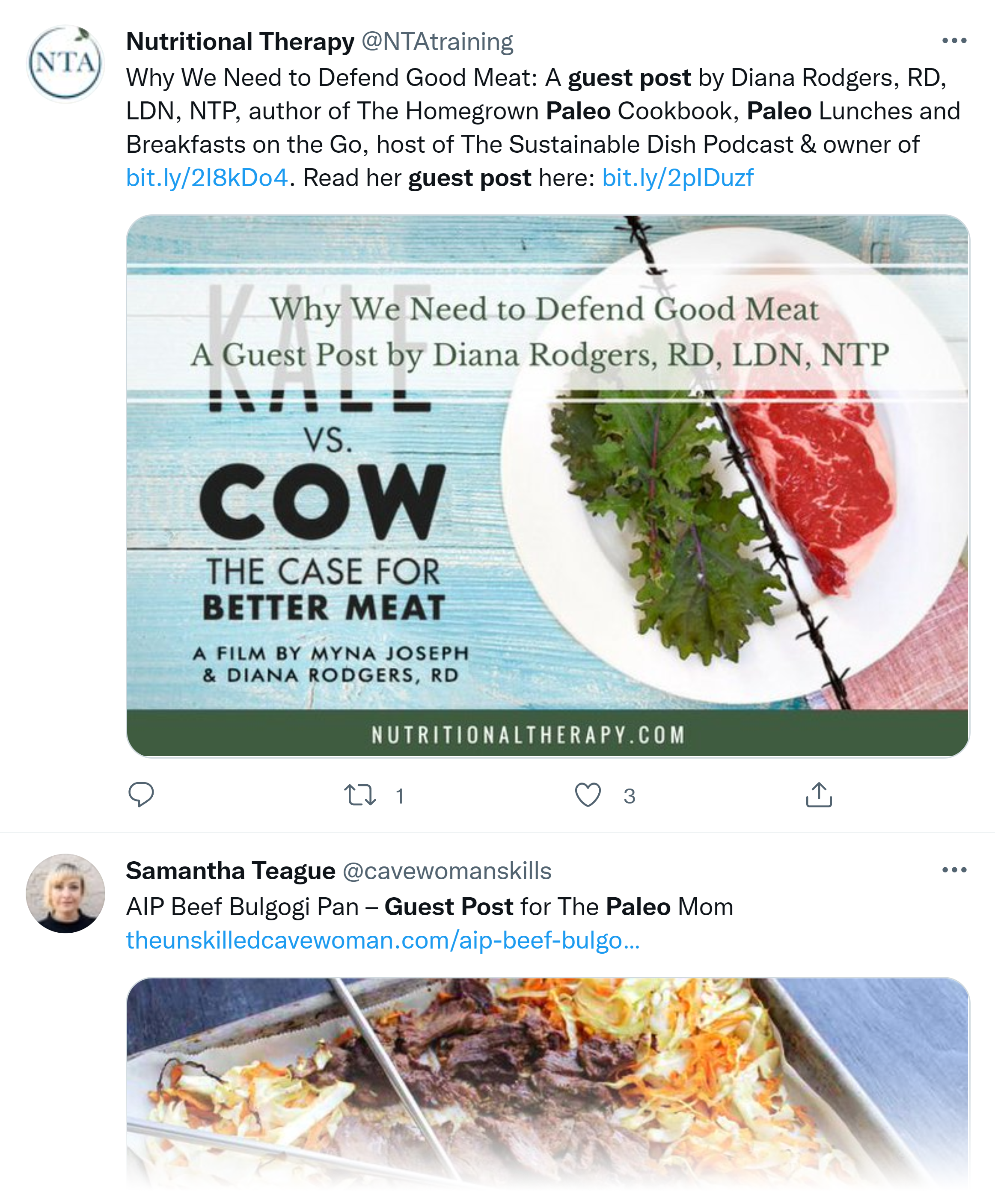
Bingo!
Within 5 seconds I found a handful of high-quality sites that accept guest posts, like this one:
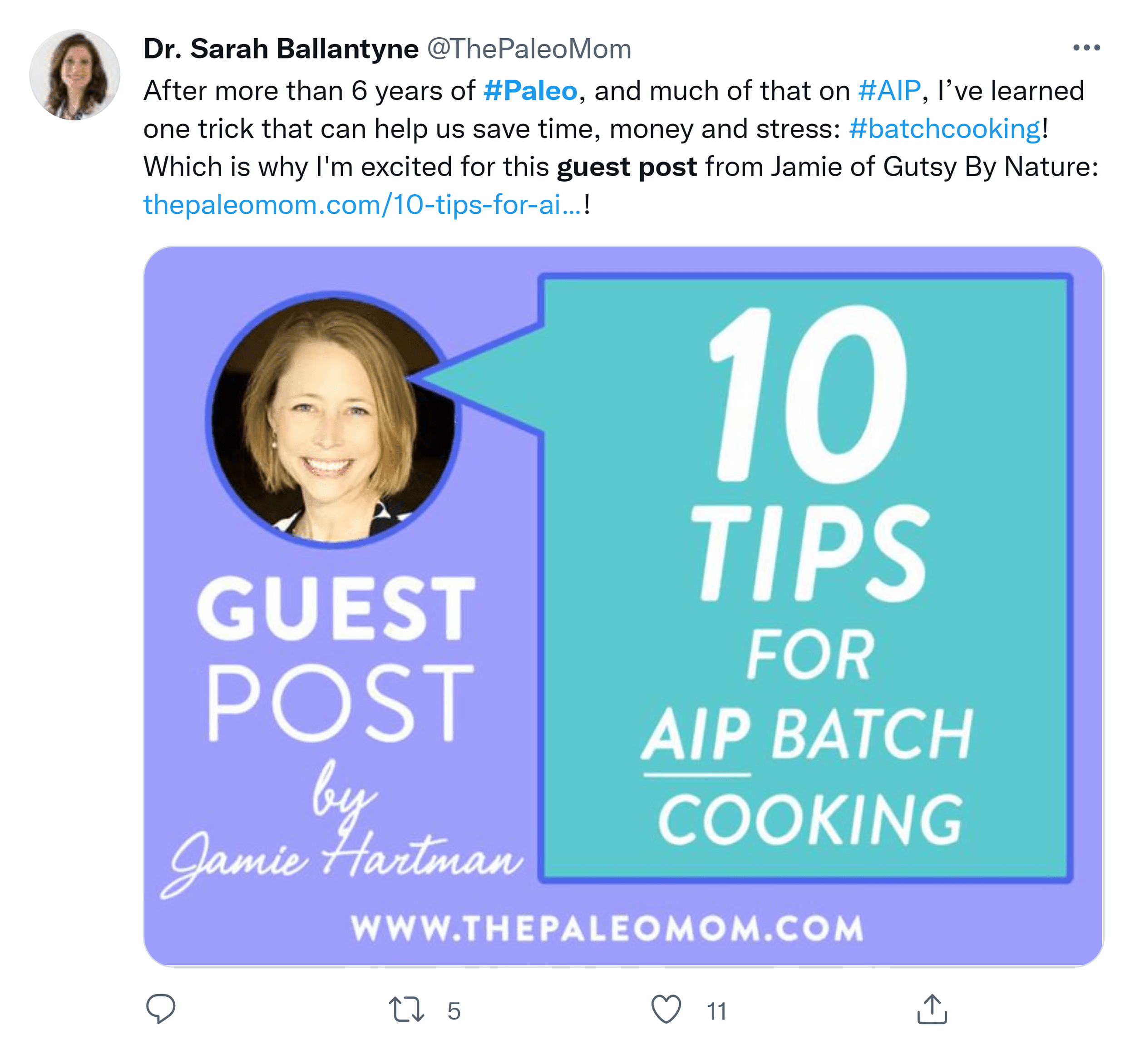
Very cool.
Technique #4: Reverse Engineer Your Competitor’s Backlinks
Here’s where you reverse engineer the backlinks of a site in your niche.
When you do, you can uncover a GOLDMINE of guest posting opportunities.
For example, I noticed that this site was ranking for a lot of keywords in my niche:

So I took the homepage URL and popped it into Semrush.

And I got a list of all their backlinks.
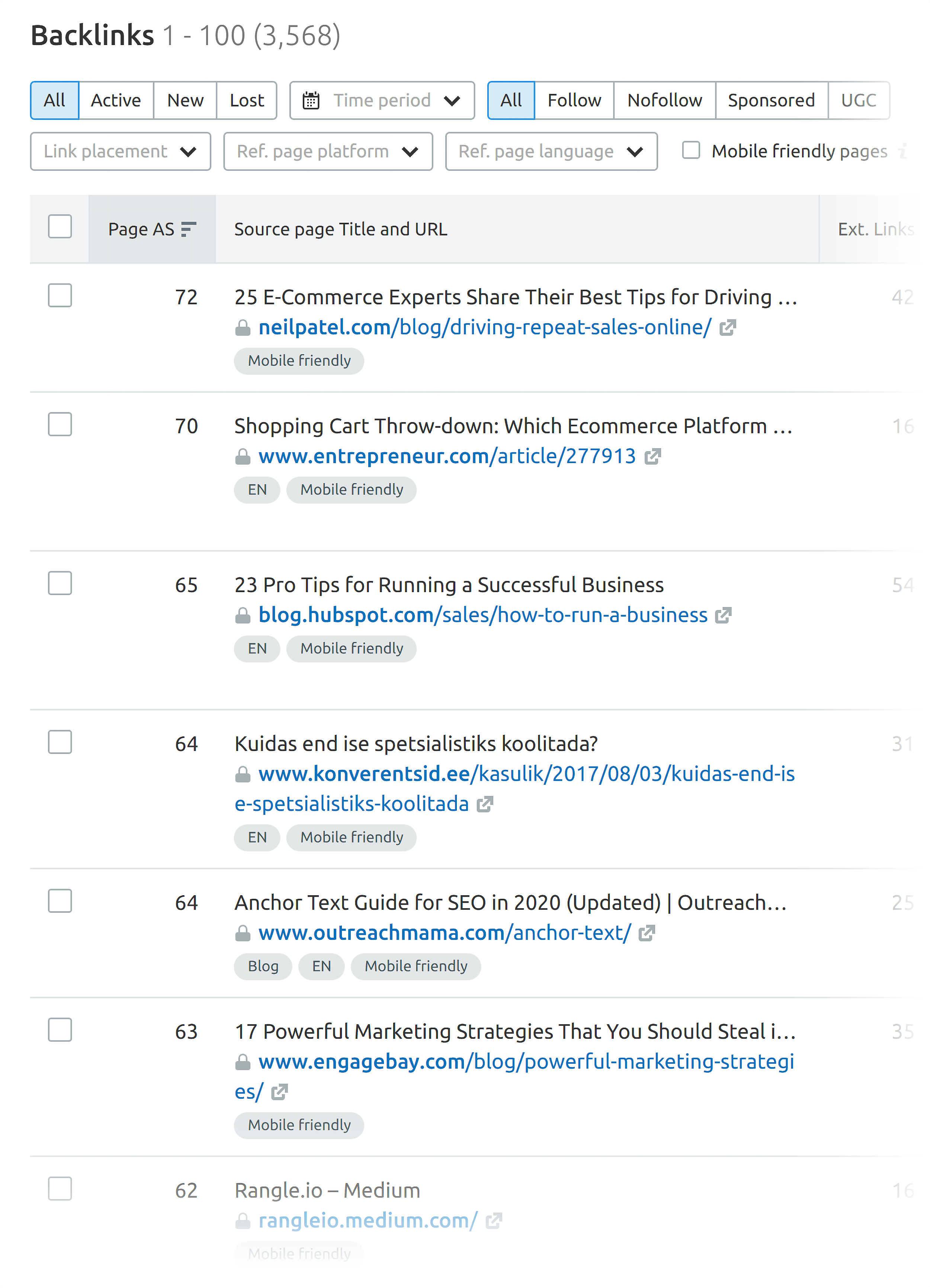
Now:
Most of their backlinks didn’t come from guest posts.
But a good chunk did.
In fact, within about 5 minutes I found (literally) 10 high-quality sites that they’ve guested posted on:

The best part about this strategy is that you can find sites that aren’t openly advertising the fact that they accept guest posts.
(In other words, sites that DON’T have a “write for us” page.)
But thanks to reverse engineering, you can find these sites with ease.
Technique #5: AllTop.com
If only there was a place that listed the best blogs on the internet.
Oh, wait there is!
It’s called AllTop.com.
Just head over to AllTop, find your topic, and you’ll get a list of the best blogs in your niche:

Of course, you won’t be able to submit a guest post to every single site listed in AllTop.
But with enough legwork, you can find a handful that do accept guest posts.
Technique #6: Blog Comment Bonanza
Warning: This is an advanced guest posting strategy.
So if you’ve never published a guest post before, skip this technique for now.
With that, here’s how it works:
You’ve probably noticed that other bloggers comment on your guest posts.
For example, here’s a guest post I published a while back:
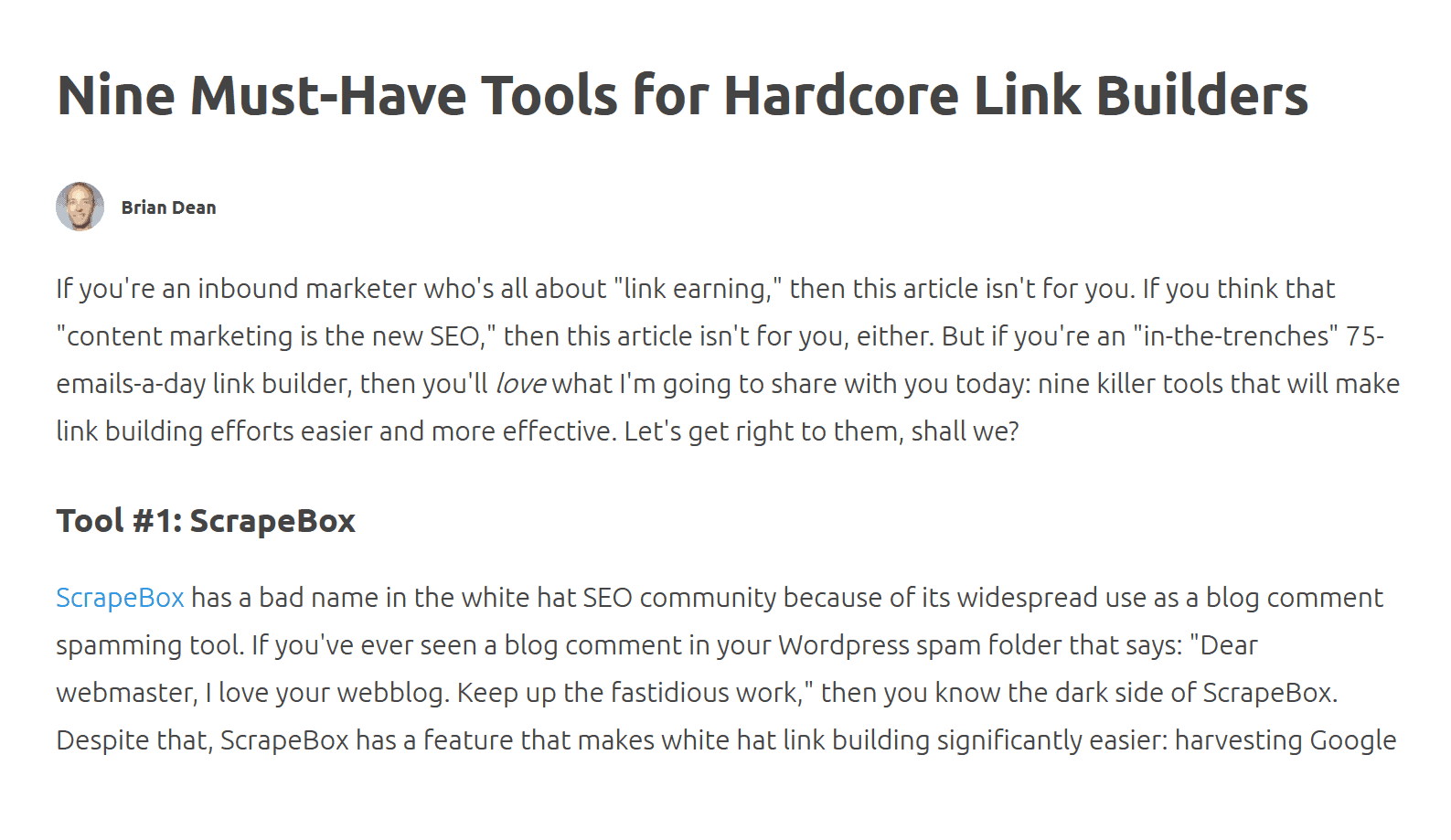
As you can see, a handful of people commented on my guest post:

And these weren’t just random people… these were folks that run blogs in my niche.
So after I replied to their comment, I sent each of them this script:
Hey [Name],
Thanks for taking the time to comment on my guest post at [Website].
I never thought of the fact that [Insert something they said in the comment].
That’s a good point.
Anyway, I actually have another guest post idea that would be perfect for your site.
It’s called: [Guest Post Title]
I could have it sent to you this week.
Either way, thanks again for your insights!
Best,
[Your First Name]
And that simple email script got me an awesome “insider” guest post opportunity from a site that didn’t have a “write for us” page.
Why does this work so well?
Well…
Someone that leaves a comment on your guest posts obviously liked your content.
(Otherwise, they wouldn’t have taken the time to leave a comment.)
So as long as you send them an amazing post, they’ll usually say “Yes!”.
#7: Lists of Sites That Accept Guest Posts
Why spend hours searching for guest posting opportunities when other people have already done the hard work for you?
For example, here’s a huge list of 300+ guest posting sites that someone made:

This post even provides stats on each site on the list:

This is a good list to get you started.
But if you want even MORE sites that accept guest posts, here are 4 lists that I use whenever I’m looking for sites to guest post on:
List of 200+ Websites & Blogs That Accept Guest Posts
List of 700+ Guest Posting Sites
List of Guest Blogging Sites (140+ best sites)
That should keep you busy for a while 🙂
Now that you’ve found a site to guest post on, it’s time for step #2…
Step #2: Get Your Guest Post Ready
At this point, you have a list of sites that accept guest posts.
Now it’s time for the next step.
In this step, I’ll show you how to find sites that are a good fit for your guest post.
You’ll also learn how to “warm-up” blog owners.
Let’s get started…
Separate Winners and Losers
First, you need to separate the wheat from the chaff.
In other words, you need to find sites that are worth writing a guest post for.
To be clear:
This isn’t about being overly picky.
In fact, if you’re just starting out, you actually want to focus on blogs that aren’t that popular.
These smaller blogs will be MUCH more likely to accept your guest post.
Then, as you get more posts under your belt, you can level up to more popular sites.
Either way, you want to guest post on sites that:
- Have an authoritative link profile
- Are in your niche (or a related niche)
- ONLY post high quality content
- Can bring you targeted traffic
- Won’t bury your link in a tiny author bio box
- Have a significant amount of social media followers
For example, a while back I published this guest post on the Buffer blog:

And when you look at that site, you realize that it checks all of these boxes…
Strong link profile? Check.
In my niche? Check.
Significant social following? Check.
Then it’s time to…
Warm Up Your Targets
If you want to guest post on an authority site, you want to get on that site’s radar screen… before you pitch.
That way, when you reach out, they’ll say:
“Oh yeah, that’s Jim, the guy who leaves all those awesome comments.”
Here’s how to do it:
1. Share on Social Media: Want to get your name etched on a blogger’s brain? Share their stuff on Twitter, Facebook and Pinterest:

2. Blog Comment: Take a few minutes to leave legitimately insightful and helpful comments on their site. Here’s a real-life example:

3. Email Them: If you’re feeling frisky, email the site owner a week or two before your pitch just to tell them how a specific piece of content helped you:
Hi [Name],
Your recent post on [Topic] really helped me out.
Specifically, I used [Technique or tip from their post]. And it [Results]!
So I just wanted to send you a quick email to say: “Thank you!”.
Thanks again,
[Your First Name]
Find The PERFECT Guest Post Topic
Here’s exactly how to find the perfect guest post topic:
1. Check out the site’s most popular posts.
These are sometimes listed in the blog’s sidebar:

Or you can use a tool (like Semrush) that lists any blog’s best-performing stuff:
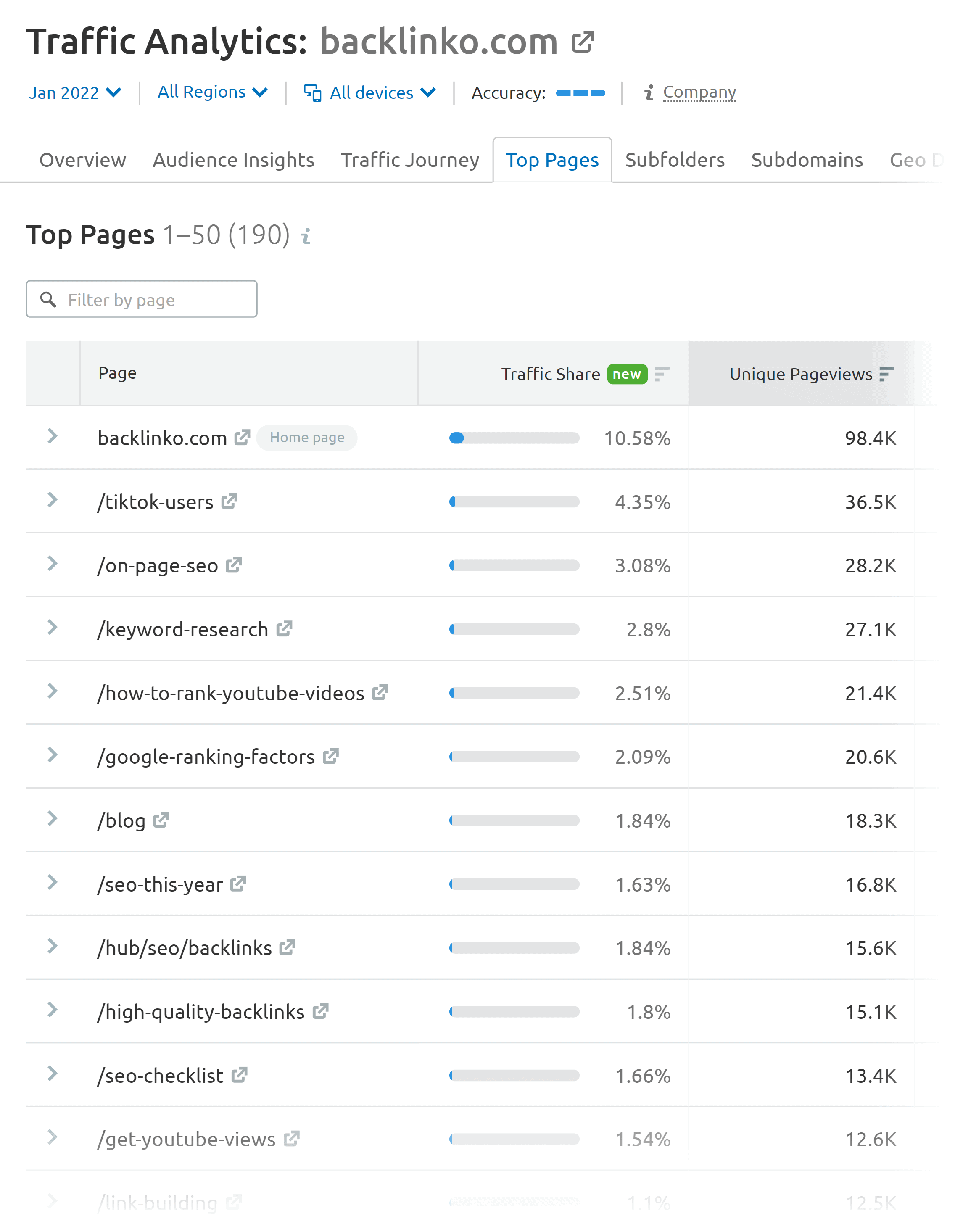
No matter how you find them, these topics are proven to generate shares, traffic and comments.
So when you send someone a guest post on that topic, they’ll say: “Content on that topic always crushes it on our blog. Perfect.”
2. Next, head over to BuzzSumo.
This is an awesome tool for finding trending topics in your niche:

Why is this important?
Well, bloggers want to publish posts that are on hot, trending topics.
(Because it means more traffic for them.)
So when you offer them content on a hot topic, they’re MUCH more likely to accept.
3. Check out their other guest posts.
What have other people posted already? This will give you an idea of what the site owner looks for when vetting posts.
For example, when I looked at the Buffer blog, I noticed that most of their guest posts were case studies.

So I decided to send them a case study for my guest post.
Simple.
4. Review The Site’s Guest Post Guidelines
I know you have better things to do with your life than to read a site’s list of guest post guidelines.
I get that.
But some bloggers have really, really specific guidelines.
Some are there to standardize their posts.
Others are there to make sure people actually read them.
Either way, it’s important that you take them to heart.
Because there’s nothing worse than writing up a 2000-word masterpiece… only to have it rejected because of a word count limit.
Step #3: Send Your Pitch
Imagine for a second that you’re the owner of a growing authority site.
You’ve got posts to write, tweets to tweet, and an overflowing inbox.
How are you going to react when you get a generic guest post pitch?
Yup! You’re gonna hit the delete button as fast as possible.
Here’s a battle-tested email template to use instead:
Hi [Name],
I’m a long-time reader. You may have noticed my comment on your post on [Article] (awesome article by the way).
I’m writing to you because I’d love to contribute a guest post on [Website].
I’ve been brainstorming some topics that I think your readers would get a ton of value from:
[Idea #1]
[Idea #2]
[Idea #3]
I’ll make sure the piece overflows with information that can’t be found anywhere else.
To give you an idea of the quality I’ll bring to your site, here’s a link to a guest post that I recently published on [Other Website].
Cheers,
[Your First Name]
Here’s what makes this email template so effective:
- Starts off with something specific about THEIR SITE
- Short and sweet (<150 words)
- Gives them 3 specific topics to choose from (less work for them)
- Soft sell
- Touches on your experience and published work
And now it’s time for…
Step #4: Write Your Guest Post
So a blogger is accepted your pitch.
Awesome.
Now you need to actually send them something.
Here’s how to do it…
My Patented “2 Tier System”
Look:
There are only so many hours in a day.
You can’t write a 3000-word ultimate guide for every site out there.
That’s why you should separate your targets into two tiers:
Tier 1: These are the top 10-20 undisputed authority sites in your niche. Sites that you can name off the top of your head. Sites you actually visit, read and follow.
Tier 2: Tier 2 sites that are blogs that are acceptable enough to warrant a high-quality guest post. But they’re not big enough to spend a week writing mind-blowing content for.
With that, let’s cover what to send Tier 1 and Tier 2 sites.
Tier 1 Content
Content for tier 1 sites should be as good or better than what you post on your own blog.
I’m talking mind-blowing pillar content that forces the hand of the site owner to hit “publish”.
Content that changes minds, sparks conversation, and spurs action.
Content that could appear on the homepage of Life Hacker or The Huffington Post.
Remember: Authority sites are authorities because they only post quality stuff. Period.
And they’re not going to drop their standards just because you commented on their site a few times.
You really need to bring it. Here’s how…
Here are 4 things you need to include in your Tier 1 guest post content:
1. Send a System: If you look at the best content on any site you’ll notice that they have one thing in common:
They lay out a complete step-by-step system for reaching an outcome.
Why? Systems have a MUCH higher perceived value than a set of random tips.
For example, with my Buffer guest post, I showed people the exact steps I used to increase my blog’s conversion rate by 134%:
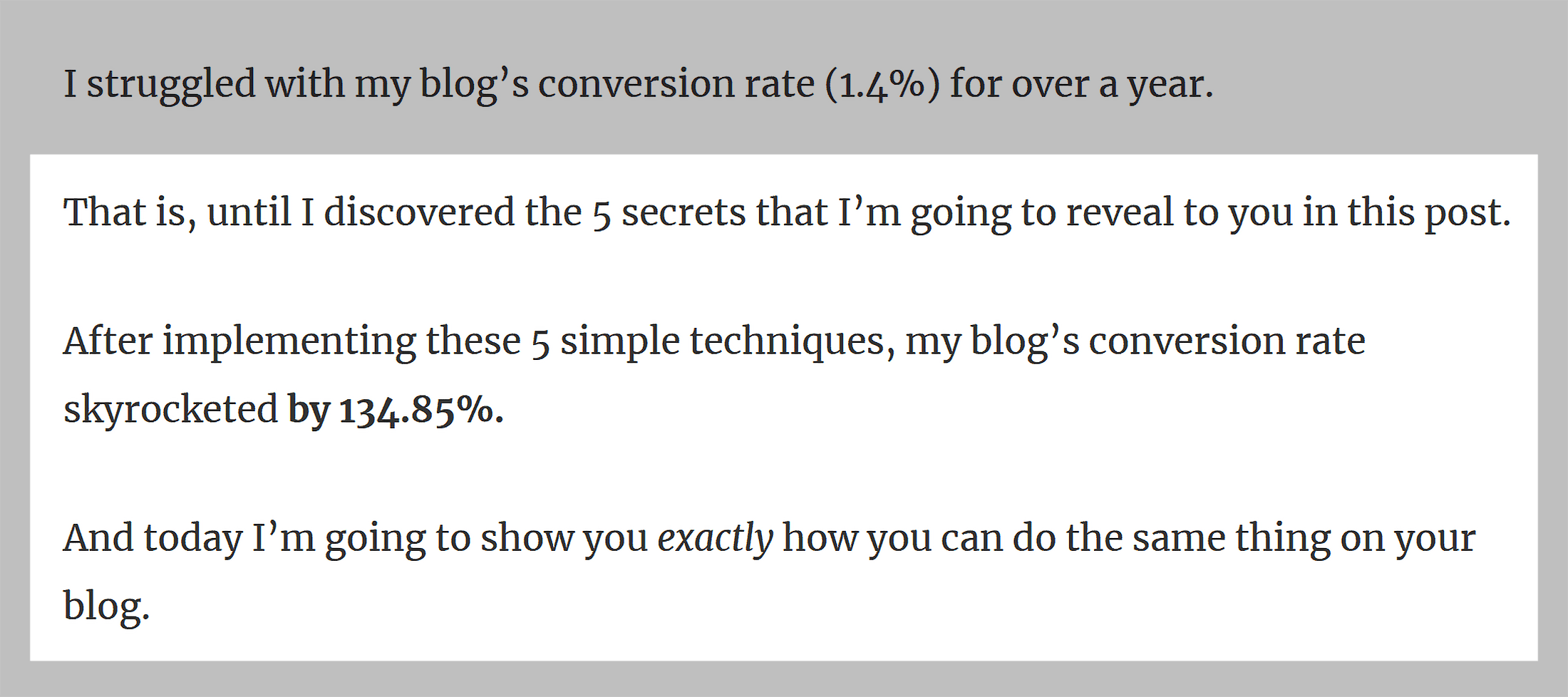
That way, people could follow the steps from the post… and improve their conversion rate.
No theory. No BS. Just a step-by-step process that anyone could follow.
2. Length is Strength: Longer articles have a higher perceived value than short posts.
That’s why I shoot for AT LEAST 2500 words for tier 1 sites.
For example, my Buffer post is a staggering 2,993 words.
But as you can see, this isn’t a bunch of fluff. It’s 2,993 words of insanely actionable content:

3. Custom Screenshots, Flowcharts and Images: Include lots of screenshots and other visuals. These help you stand out… and add lots of meaty value to the post.
As you can see, I made sure to include A TON of screenshots in my Buffer guest post.
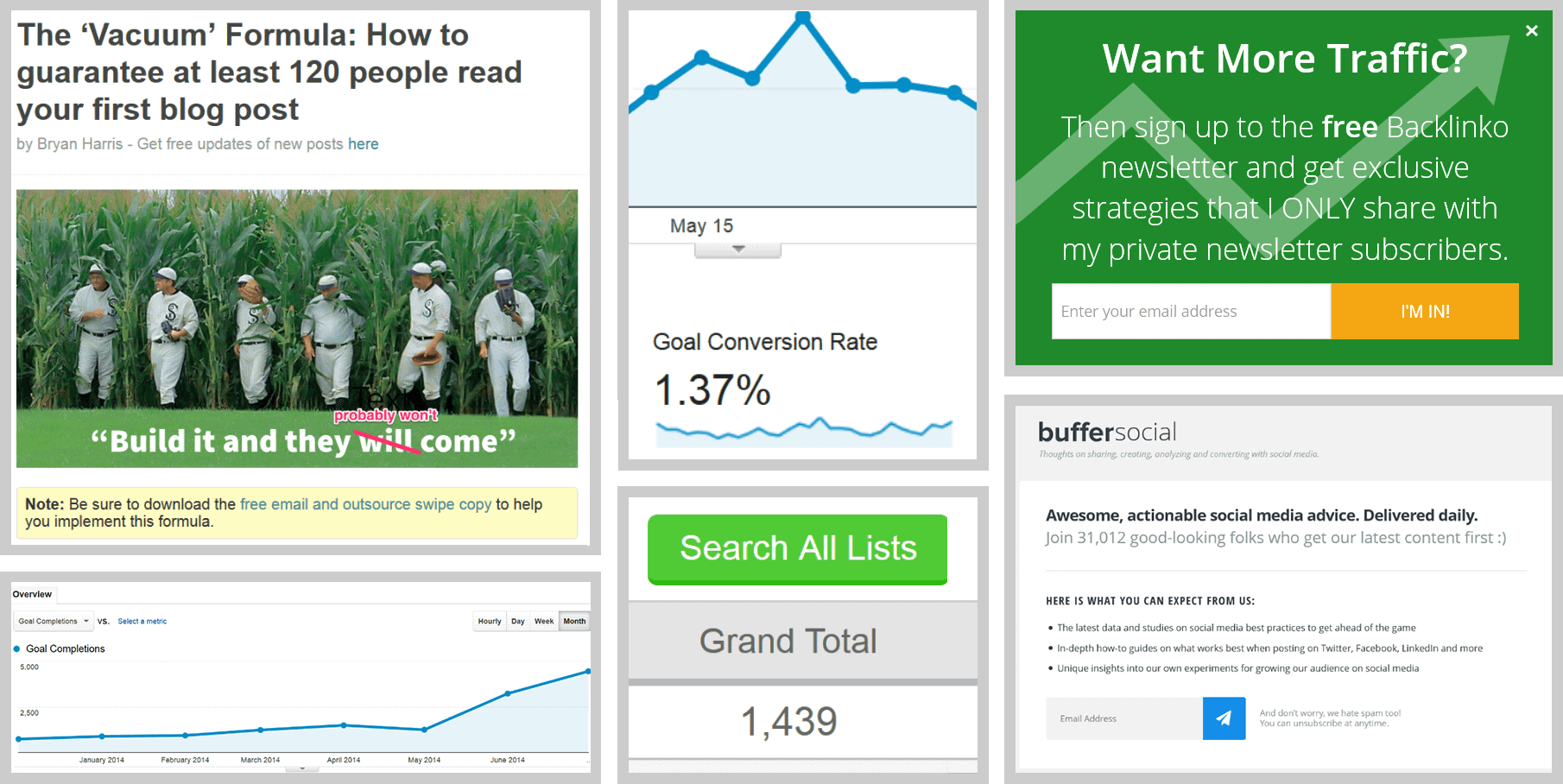
4. Internal Links: Internal links are GREAT for SEO. So make sure to link to some of the site’s other content in your guest post.
This shows that went the extra mile to make your guest post as valuable as possible.
For example, I linked to a handful of other posts on the Buffer blog:

Yes, it took some extra effort to find posts from their blog to link to. But in the end, it showed the Buffer team that I actually cared.
Tier 2 Content
Tier 2 sites deserve some love too.
If they’re on your list of targets, the blog must have something going for them.
While I don’t go crazy for these sites… I still send something of value.
It just isn’t quite as amazing as the stuff I send Tier 1 sites.
Step #5: Follow Up
Here are some things I do to get the most from every guest post:
1. Actively Respond to Comments: Don’t post and run. Take the time to respond to people’s comments as they roll in. In fact, I usually leave a comment right after my post goes live to show everyone that I’m hanging out to answer comments:

Then, I do my best to reply to all comments that come in within the first 48 hours:
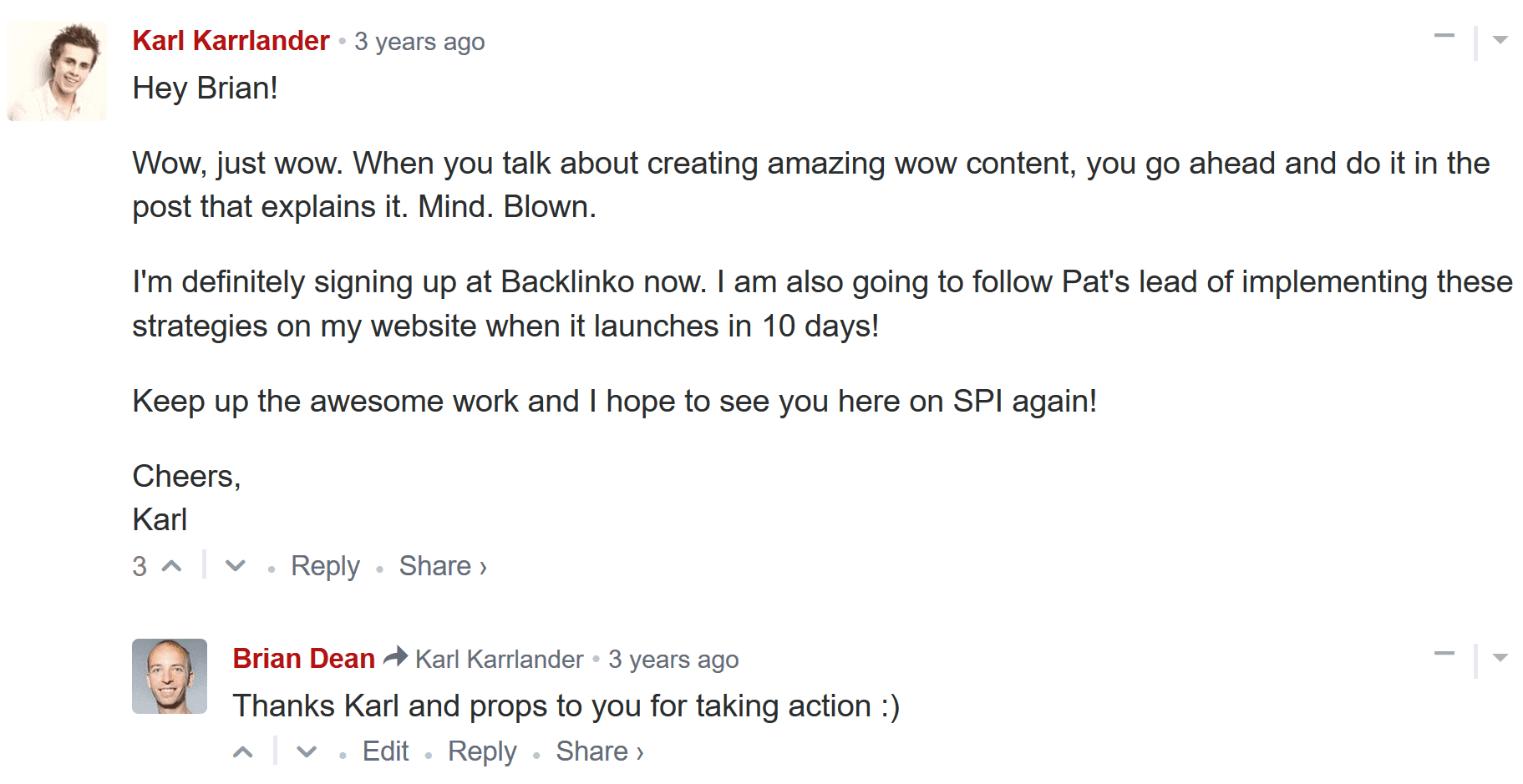
2. Promote Your Guest Post On Social Media:

This is a win-win-win: The site you guest posted on gets some traffic. And you share an awesome blog post with your community.
3. Send a Thank You Note: I usually send Tier 1 sites a quick follow-up email letting them know I appreciated the opportunity. Again: this is something that no one does. So this little thank you note really helps you stand out. It also keeps the line open for the next time you want to guest post on their site.
4. Blog Comment Bonanza: As I mentioned way back in Step #1, I’ll sometimes reach out to people that commented on my guest post… and ask to publish a guest post on their site.
Bonus Step #1: The Expanded Guest Post
Yes, traffic and links are great.
But building your email list is an underrated benefit of guest blogging.
And to build your email list with guest posting, you NEED to try the Expanded Guest Post.
It’s a 3-step process that I use to turn guest post traffic into leads (and sales).
Here’s how it works:
1. First, create a “bonus” resource.
This is something related to your guest post.
It could be an ebook.
It could be a video.
The specific format doesn’t matter.
What’s important is that it’s on the same topic as your guest post.
For example, here’s the bonus I made for my Buffer guest post:

As you can see, it’s a smattering of tips that I didn’t have room for in the guest post.
(And all of these tips are related to my guest post topic: building your email list.)
I also threw in a few PDF checklists about list building.

2. Next, create a page specifically for people that read your guest post.
This page should offer your bonus section in exchange for an email.
Here’s mine:

(Feel free to copy it.)
3. Lastly, pitch your bonus section at the end of your guest post.
Here’s an example:
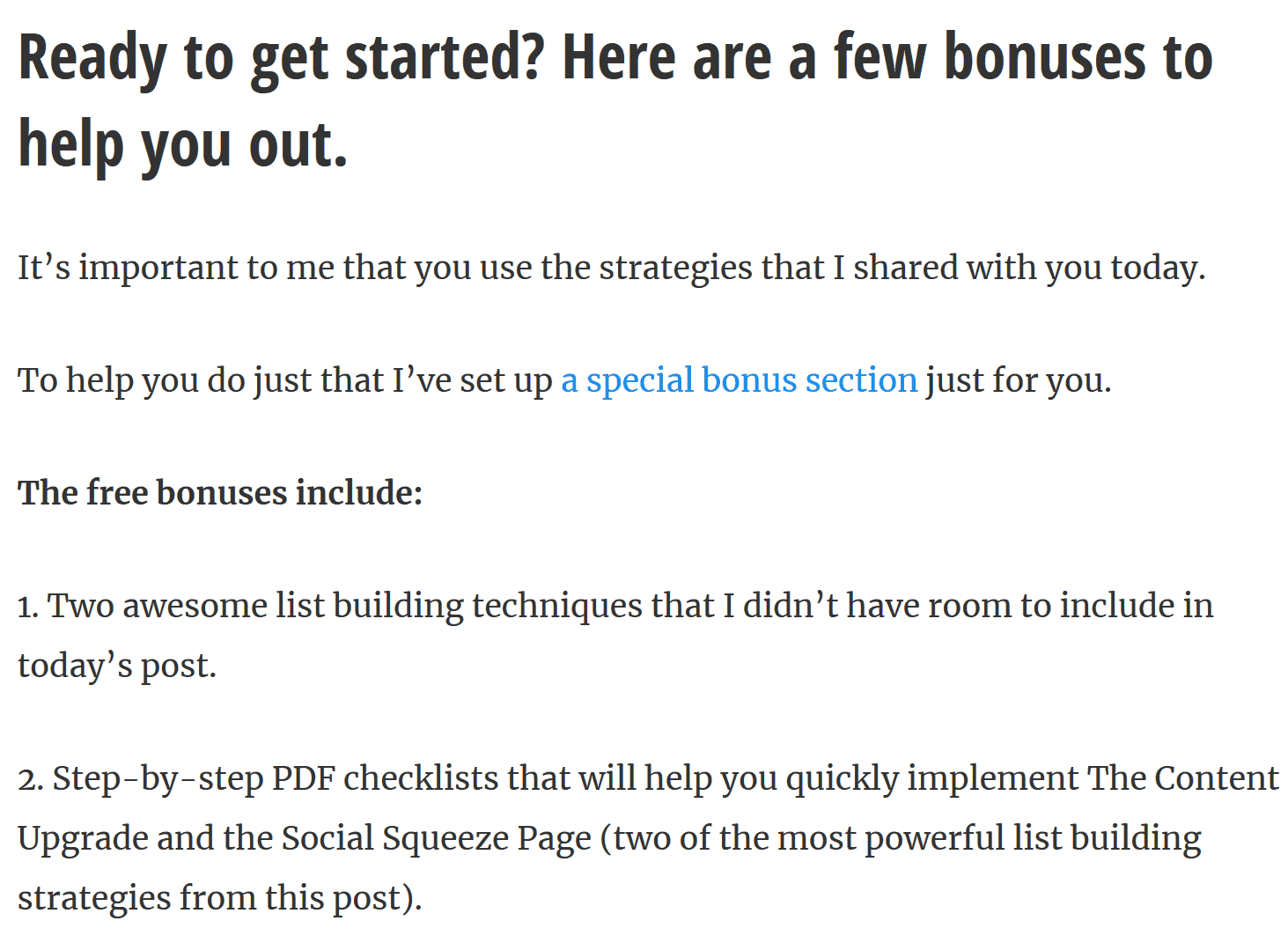
And this strategy worked out GREAT.
In fact, I build an extra 188 email subscribers using this simple strategy on my Buffer guest post:

(And as you can see in that screenshot, the page I sent people to converted at 37.8%. Not bad!)
Bonus Step #2: Guest Blogging Pro Tips
Let’s cap things off with a handful of pro tips that I’ve picked up over the years.
1. Use Comments to Estimate Referral Traffic
How do you know how much traffic you’ll get from your guest post?
If you think “bigger site=more traffic”, you’re wrong.
I’ll explain…
A few years ago I published a guest post on Pat Flynn’s blog.
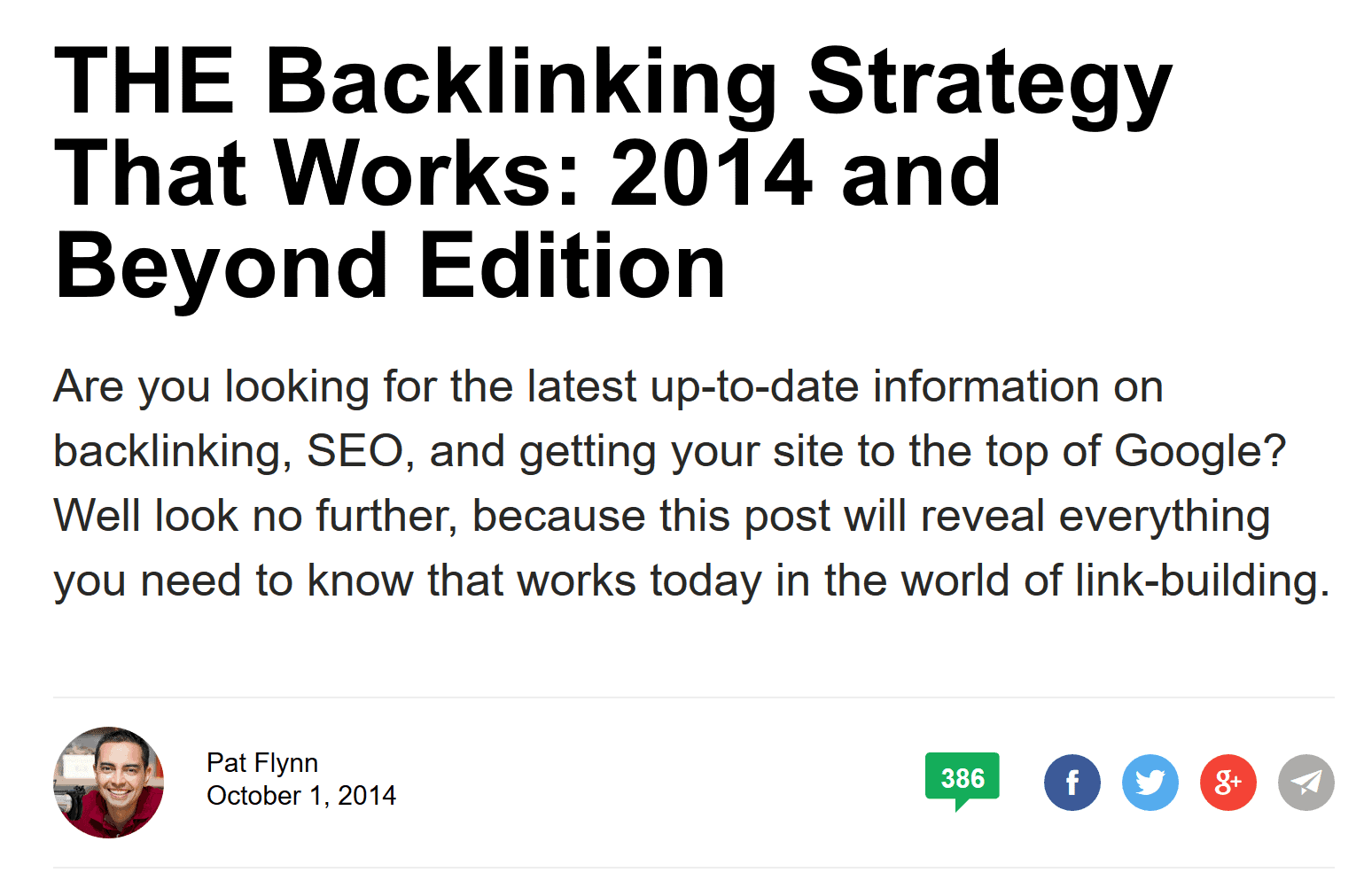
Around that time I also published a guest post on one of the biggest marketing sites online.
(I don’t want to throw shade on anyone. So I won’t name the site.)
Now:
Pat’s site is popular. But this marketing site is HUGE.
Which one do you think sent me the most traffic?
Pat’s blog… by a mile:
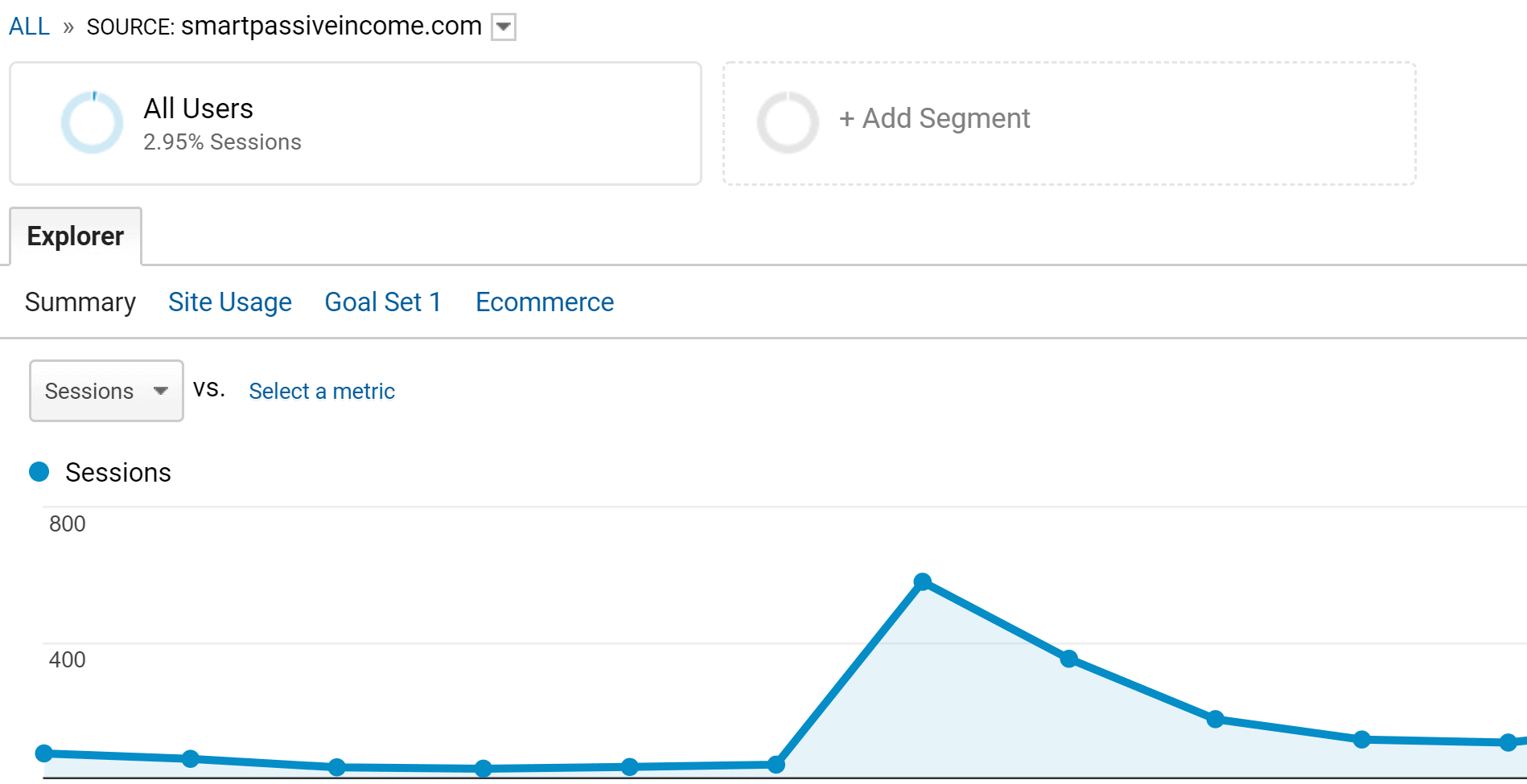
And when I look at how many comments each blog tends to get, it’s not even close.
(Pat’s blog gets 50+ comments per post. The marketing site? Around 10 comments per post.)
This isn’t an isolated example.
From publishing over 200 guest posts, I’ve noticed a consistent pattern:
More comments=more traffic.
The reason?
Big sites get lots of visitors. But they don’t have many readers.
And the best way to estimate readers? See how many comments their blog posts get.
Bottom line? The more comments a blog gets, the more traffic you can expect from your guest post.
2. Include a Contextual Backlink
As Google’s Matt Cutts famously proclaimed, Google probably ignores links in guest post author bio sections, like this:

That’s why you want to include at least one contextual backlink in your guest post.
To give you an idea of what I mean, here’s a contextual link from one of my guest posts:
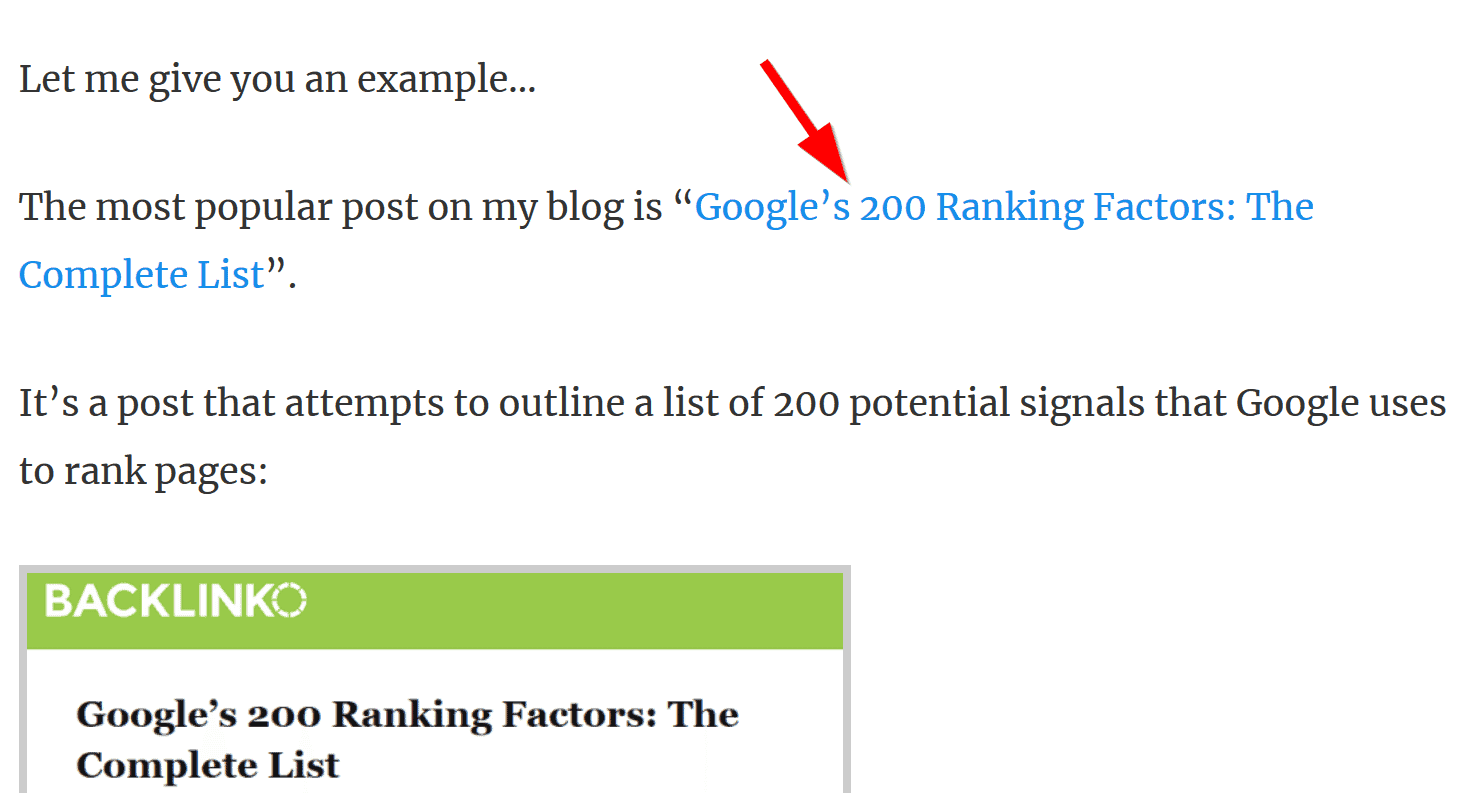
As you can see, my link fits naturally in the content. It’s not remotely spammy or forced.
3. Guest Post Using Infographics
This is a black belt strategy that’s helped me get featured on authority news sites and blogs.
This video will walk you through the entire process:
4. Use Author Bio Footprints
Here’s a great way to find “hidden” guest post opportunities.
First, find someone in your niche that’s a prolific guest poster.

Then, grab a snippet of text from their bio.

And pop that text into Google (in quotes).

And – bam! – you’ve just found dozens of sites to guest post on.

4. Sell Yourself In Your Author Bio
Let’s face it:
Most author bios are BORING.
And that’s one of the main reasons that most guest posts generate so few visitors.

Instead, your author bio should make people WANT to click over and visit your site.
For example, here’s an author bio from one of my guest posts:

See how I outline WHY my site is worth visiting?
That’s one of the main reasons that this guest post sent me a boatload of traffic:

Conclusion
So that’s my step-by-step guide to guest blogging.
Now I’d like to turn it over to you:
Which tactic from this guide are you going to use first?
Are you ready to write better author bios?
Or maybe you want to find guest posting opportunities with Google reverse image search.
Either way, let me know in the comments section below.